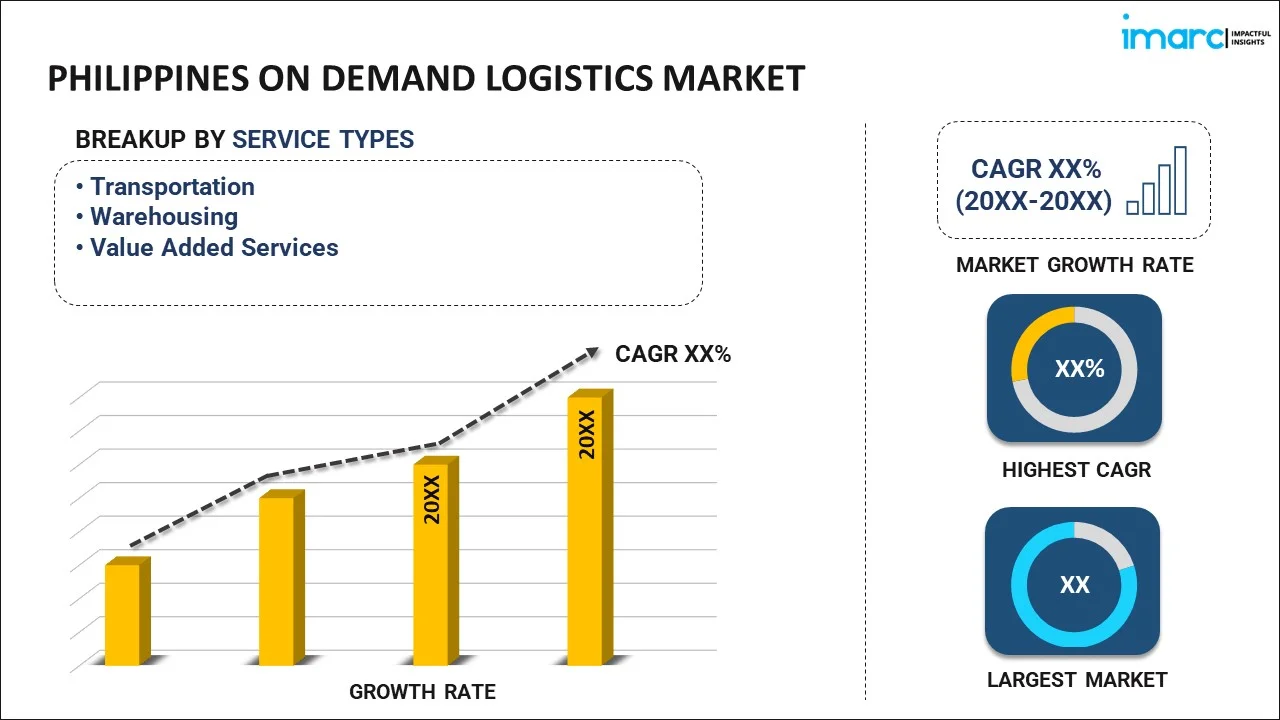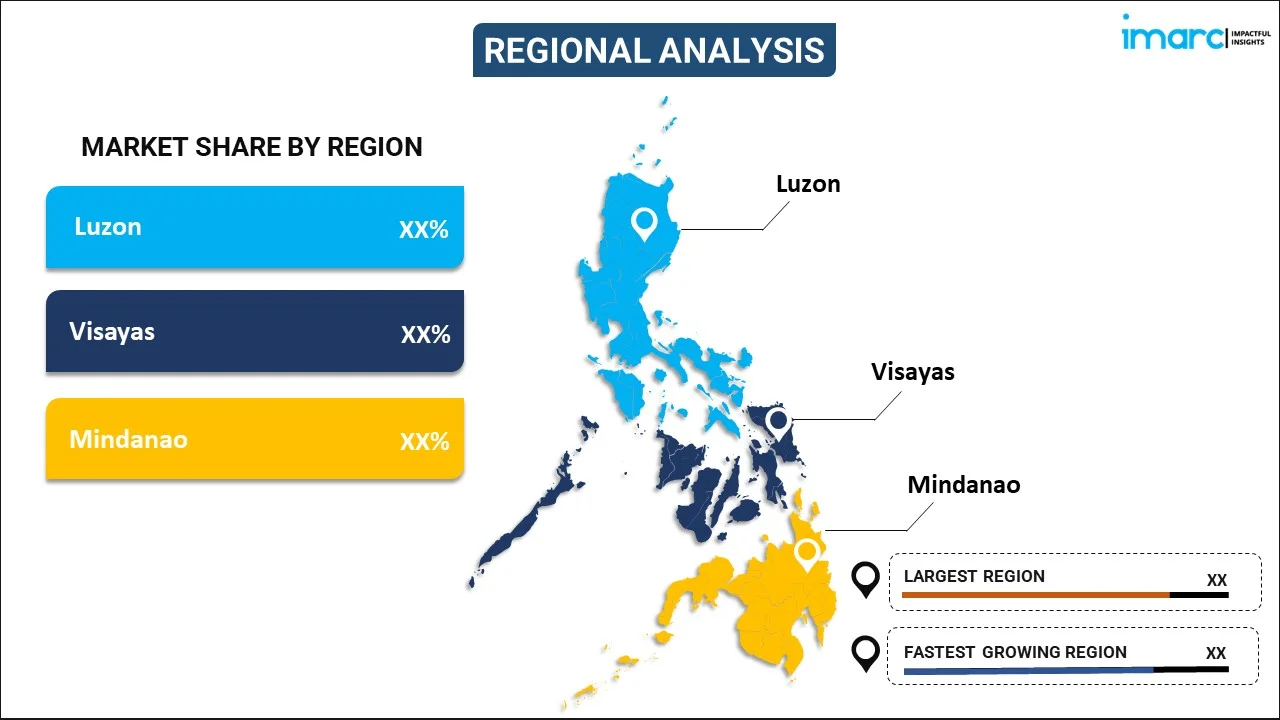
Philippines On Demand Logistics Market Report by Service Type (Transportation, Warehousing, Value Added Services), End User (B2B, B2C, C2C), Application (Retail and E-commerce, Healthcare, Manufacturing, Documents and Letters, and Others), and Region 2025-2033
Philippines On Demand Logistics Market Overview:
The Philippines on demand logistics market size reached USD 1.0 Billion in 2024. Looking forward, IMARC Group expects the market to reach USD 3.5 Billion by 2033, exhibiting a growth rate (CAGR) of 13.6% during 2025-2033. The growth of e-commerce sector, infrastructure development, government initiatives, and extensive demand of smooth internet connection by Filipinos represent some of the key factors driving the growth of the market.
|
Report Attribute
|
Key Statistics
|
|---|---|
|
Base Year
|
2024 |
|
Forecast Years
|
2025-2033
|
|
Historical Years
|
2019-2024
|
| Market Size in 2024 | USD 1.0 Billion |
| Market Forecast in 2033 | USD 3.5 Billion |
| Market Growth Rate (2025-2033) | 13.6% |
Philippines On Demand Logistics Market Trends:
Growing E-commerce Sector
The new economy businesses are contributing to the growth of the on-demand logistics market in the Philippines, particularly the e-commerce industry. In 2021, smartphone household penetration reached 74.1%, a 2% increase from 2020. Based on a 2021 PPRO Ecommerce and Payments report, 50% of Filipino online shoppers have made cross-border transactions, mostly from China, the United States, and South Korea. Due to the increasing popularity and availability of internet selling sites, the demand for swift and effective logistic services is on the rise. With more Filipinos now utilizing the Internet for purchasing purposes, logistics providers are under pressure to deliver the goods more quickly and from many more locations. Lately, consumption trends of such goods have led to increased pressure on delivery time frames, boosting the importance of immediate logistics services. Such trend is further supported by the development in mobile application and real-time tracking, which creates a better perception to the customer due to the element of credibility of the delivery process.
Infrastructure Development and Government Initiatives
Strong development of infrastructure and growing government support measures have put positive impact for the on-demand logistics market growth in the Philippines. The National Economic and Development Authority (NEDA) of the Philippines is where the DPWH will present the Kennon Road project for final approval. The 33km road has to be widened, 18 bridges need to be upgraded, and slope protection needs to be built. The government is actively pursuing strategies for infrastructural development, particularly in transport infrastructure such as roads, ports, and airports, to enhance logistics efficiency. Initiatives like the “Build, Build, Build” plan are improving access across the Philippine archipelago, reducing transit times and costs. Additionally, government policies promoting digitalization and innovation are driving the integration of advanced technologies in the logistics industry. These efforts not only boost operational efficiency but also attract overseas investment, creating a competitive and evolving on-demand logistics services market environment.
Philippines On Demand Logistics Market News:
- In July 2023, DB Schenker, a global logistics provider, and Volvo Cars entered a partnership for more sustainable ocean freight, shipping 12,000 standard containers (TEU) with automotive spare parts on vessels using biofuel that will reduce CO2 emissions by 84% per container. In total, over a year, this saves roughly 9,000 tons of CO2 compared to ocean freight vessels powered by fossil fuel.
- In February 2023, DHL Express, a global logistics company, upgraded its dedicated aircraft from A300 to A330-300 as part of the company's continued investment in its Philippine operations to serve the growing demand from consumers. The new upgrade, operated by Air Hong Kong, will provide a 31% increase in capacity from 42 tons to 55 tons with 12 weekly flights to serve the route of Hong Kong-Manila-Cebu-Manila-Hong Kong.
Philippines On Demand Logistics Market Segmentation:
IMARC Group provides an analysis of the key trends in each segment of the market, along with forecasts at the country level for 2025-2033. Our report has categorized the market based on service type, end user, and application.
Service Type Insights:

- Transportation
- Warehousing
- Value Added Services
The report has provided a detailed breakup and analysis of the market based on the service type. This includes transportation, warehousing, and value added services.
End User Insights:
- B2B
- B2C
- C2C
The report has provided a detailed breakup and analysis of the market based on the end user. This includes B2B, B2C, and C2C.
Application Insights:
- Retail and E-commerce
- Healthcare
- Manufacturing
- Documents and Letters
- Others
The report has provided a detailed breakup and analysis of the market based on the application. This includes retail and e-commerce, healthcare, manufacturing, documents and letters, and others.
Regional Insights:

- Luzon
- Visayas
- Mindanao
The report has also provided a comprehensive analysis of all the major regional markets, which include Luzon, Visayas, and Mindanao.
Competitive Landscape:
The market research report has also provided a comprehensive analysis of the competitive landscape. Competitive analysis such as market structure, key player positioning, top winning strategies, competitive dashboard, and company evaluation quadrant has been covered in the report. Also, detailed profiles of all major companies have been provided.
Philippines On Demand Logistics Market Report Coverage:
| Report Features | Details |
|---|---|
| Base Year of the Analysis | 2024 |
| Historical Period | 2019-2024 |
| Forecast Period | 2025-2033 |
| Units | Billion USD |
| Scope of the Report | Exploration of Historical and Forecast Trends, Industry Catalysts and Challenges, Segment-Wise Historical and Predictive Market Assessment:
|
| Service Types Covered | Transportation, Warehousing, Value Added Services |
| End Users Covered | B2B, B2C, C2C |
| Applications Covered | Retail and E-commerce, Healthcare, Manufacturing, Documents and Letters, Others |
| Regions Covered | Luzon, Visayas, Mindanao |
| Customization Scope | 10% Free Customization |
| Post-Sale Analyst Support | 10-12 Weeks |
| Delivery Format | PDF and Excel through Email (We can also provide the editable version of the report in PPT/Word format on special request) |
Key Questions Answered in This Report:
- How has the Philippines on demand logistics market performed so far and how will it perform in the coming years?
- What has been the impact of COVID-19 on the Philippines on demand logistics market?
- What is the breakup of the Philippines on demand logistics market on the basis of service type?
- What is the breakup of the Philippines on demand logistics market on the basis of end user?
- What is the breakup of the Philippines on demand logistics market on the basis of application?
- What are the various stages in the value chain of the Philippines on demand logistics market?
- What are the key driving factors and challenges in the Philippines on demand logistics?
- What is the structure of the Philippines on demand logistics market and who are the key players?
- What is the degree of competition in the Philippines on demand logistics market?
Key Benefits for Stakeholders:
- IMARC’s industry report offers a comprehensive quantitative analysis of various market segments, historical and current market trends, market forecasts, and dynamics of the Philippines on demand logistics market from 2019-2033.
- The research report provides the latest information on the market drivers, challenges, and opportunities in the Philippines on demand logistics market.
- Porter's five forces analysis assist stakeholders in assessing the impact of new entrants, competitive rivalry, supplier power, buyer power, and the threat of substitution. It helps stakeholders to analyze the level of competition within the Philippines on demand logistics industry and its attractiveness.
- Competitive landscape allows stakeholders to understand their competitive environment and provides an insight into the current positions of key players in the market.
Need more help?
- Speak to our experienced analysts for insights on the current market scenarios.
- Include additional segments and countries to customize the report as per your requirement.
- Gain an unparalleled competitive advantage in your domain by understanding how to utilize the report and positively impacting your operations and revenue.
- For further assistance, please connect with our analysts.
 Inquire Before Buying
Inquire Before Buying
 Speak to an Analyst
Speak to an Analyst
 Request Brochure
Request Brochure
 Request Customization
Request Customization




.webp)




.webp)












